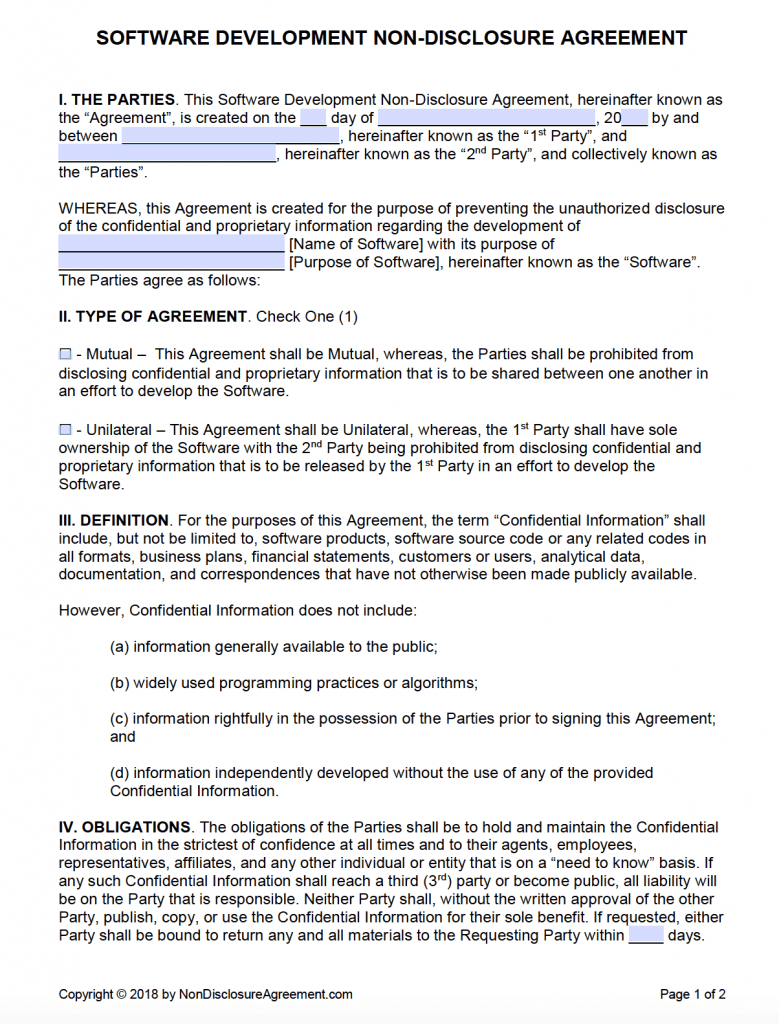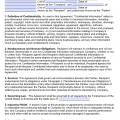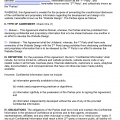Software Development Non-Disclosure Agreement (NDA)

The software development non-disclosure agreement (NDA) is intended for use when sharing software business trade secrets with consultants, investors, contractors, potential licensees, and anyone else who has access to your company’s confidential information. Such information could include your unpublished computer code, design definitions and specifications, flow diagrams and flowcharts, formulas and algorithms, system and user documentation, data structures and data compilations, marketing and sales data, customer lists, and pending patent applications. If you are providing software to beta testers, you should use the Software Beta Tester Non-Disclosure Agreement.
Website Design NDA – To keep design efforts in confidence with designers, programmers, or anyone else working on the website.
Sample
Software Development Non-Disclosure Agreement (NDA)
This Software Development Non-Disclosure Agreement (the “Agreement”) is entered into by and between _______________,with its principal offices at _______________, (“Disclosing Party”) and _______________, located at _______________ (“Receiving Party”) for the purpose of preventing the unauthorized disclosure of Confidential Information as defined below. The parties agree to enter into a confidential relationship with respect to the disclosure of certain proprietary and confidential information (“Confidential Information”).
1. Definition of Confidential Information
For purposes of this Agreement, “Confidential Information” shall include all information or material that has or could have commercial value or other utility in Disclosing Party’s business, and is treated with confidentiality. Such information includes, but is not limited to: unpublished computer code, design definitions and specifications, flow diagrams and flowcharts, formulas and algorithms, system and user documentation, data structures and data compilations, marketing and sales data, customer lists, and pending patent applications. If Confidential Information is in written form, the Disclosing Party shall label or stamp the materials with the word “Confidential” or some similar warning. If Confidential Information is transmitted orally, the Disclosing Party shall promptly provide a writing indicating that such oral communication constituted Confidential Information.
2. Exclusions from Confidential Information
Receiving Party’s obligations under this Agreement do not extend to information that is: (a) publicly known at the time of disclosure or subsequently becomes publicly known through no fault of the Receiving Party; (b) discovered or created by the Receiving Party before disclosure by Disclosing Party; (c) learned by the Receiving Party through legitimate means other than from the Disclosing Party or Disclosing Party’s representatives; or (d) is disclosed by Receiving Party with Disclosing Party’s prior written approval.
3. Obligations of Receiving Party
Receiving Party shall hold and maintain the Confidential Information in strictest confidence for the sole and exclusive benefit of the Disclosing Party. Receiving Party shall carefully restrict access to Confidential Information to employees, contractors and third parties as is reasonably required and shall require those persons to sign nondisclosure restrictions at least as protective as those in this Agreement. Receiving Party shall not, without prior written approval of Disclosing Party, use for Receiving Party’s own benefit, publish, copy, or otherwise disclose to others, or permit the use by others for their benefit or to the detriment of Disclosing Party, any Confidential Information. Receiving Party shall return to Disclosing Party any and all records, notes, and other written, printed, or tangible materials in its possession pertaining to Confidential Information immediately if Disclosing Party requests it in writing.
The nondisclosure provisions of this Agreement shall survive the termination of this Agreement and Receiving Party’s duty to hold Confidential Information in confidence shall remain in effect until the Confidential Information no longer qualifies as a trade secret or until Disclosing Party sends Receiving Party written notice releasing Receiving Party from this Agreement, whichever occurs first.
Nothing contained in this Agreement shall be deemed to constitute either party a partner, joint venturer or employee of the other party for any purpose.
If a court finds any provision of this Agreement invalid or unenforceable, the remainder of this Agreement shall be interpreted so as best to effect the intent of the parties.
This Agreement expresses the complete understanding of the parties with respect to the subject matter and supersedes all prior proposals, agreements, representations and understandings. This Agreement may not be amended except in a writing signed by both parties.
The failure to exercise any right provided in this Agreement shall not be a waiver of prior or subsequent rights.
Any misappropriation of Confidential Information in violation of this Agreement may cause Disclosing Party irreparable harm, the amount of which may be difficult to ascertain, and therefore Receiving Party agrees that Disclosing Party shall have the right to apply to a court of competent jurisdiction for an order enjoining any such further misappropriation and for such other relief as Disclosing Party deems appropriate. This right of Disclosing Party is to be in addition to the remedies otherwise available to Disclosing Party.
Receiving Party agrees to indemnify Disclosing Party against any and all losses, damages, claims or expenses incurred or suffered by Disclosing Party as a result of Receiving Party’s breach of this Agreement.
11. Attorney Fees and Expenses
In a dispute arising out of or related to this Agreement, the prevailing party shall have the right to collect from the other party its reasonable attorney fees and costs and necessary expenditures.
The parties consent to the exclusive jurisdiction and venue of the federal and state courts located in _________________ in any action arising out of or relating to this Agreement. The parties waive any other venue to which either party might be entitled by domicile or otherwise.
This Agreement shall be governed in accordance with the laws of the State of _________________.
This Agreement shall bind each party’s heirs, successors and assigns. Receiving Party may not assign or transfer its rights or obligations under this Agreement without the prior written consent of Disclosing Party.
Disclosing Party:
_____________________________________________ (Signature)
_____________________ (Typed or Printed Name)
Title: _____________________
Date: _____________________
Receiving Party:
_____________________________________________ (Signature)
_____________________ (Typed or Printed Name)
Title: _____________________
Date: _____________________
How to Write
EXPLANATION FOR SOFTWARE DEVELOPMENT NON-DISCLOSURE AGREEMENT
Below we provide an explanation for each of the provisions in the Software Development Non-Disclosure Agreement Agreement.
Introductory Paragraph
The “Disclosing Party” is the person disclosing secrets, and “Receiving Party” is the person or company who receives the confidential information and is obligated to keep it secret. The
terms are capitalized to indicate they are defined within the agreement. The sample agreement is a “one-way” (or in legalese, “unilateral”) agreement—that is, only one party is disclosing secrets. If either of the parties is a business, not an individual, use the proper name of the business and designate if it is a partnership, LLC or corporation (for example, “Windgrown, Inc., a California corporation.”)
1. Definition of Confidential Information. Every nondisclosure agreement defines its trade secrets, often referred to as “confidential information.” This definition establishes the subject matter of the disclosure. Keep in mind that when you disclose secrets, you should designate that information as confidential.
2. Exclusions from Confidential Information. This provision describes all the types of information that are not covered by the agreement. These exclusions are based on court decisions and state trade secret laws that say these types of information do not qualify for trade secret protection.
3. Obligations of Receiving Party. This clause makes clear that the secrets must be kept in confidence by the receiving party and may not be revealed to others without prior written consent.
4. Time Periods. This clause provides the parties with an expiration date for the agreement. The agreement should last as long as the information is likely to remain a trade secret. Five years is a common period, but it can be much shorter, even as little as six months. In Internet and technology businesses, the time period may need to be shorter because of the fast pace of innovation.
5. Relationships. Most agreements include a provision like this one, disclaiming any relationship other than that defined in the agreement.
6. Severability. The severability clause provides that if the parties wind up in a lawsuit over the agreement and a court rules that one part of the agreement is invalid, that part can be cut out and the rest of the agreement will remain valid.
7. Integration. The integration provision verifies that the version you are signing is the final version and that neither of you can rely on statements made in the past.
8. Waiver. This provision states that even if you don’t promptly complain about a violation of the NDA, you still have the right to complain about it later.
9. Injunctive Relief. An injunction is a court order directing a person to do (or stop doing) something. If someone violated your NDA, you would want a court order directing that person to stop using your secrets.
10. Indemnity. Some NDAs require the Receiving Party to pay for all damages (lost profits, attorney fees or other expenses) incurred by the other party as a result of the Receiving Party’s breach of the nondisclosure agreement. This obligation is known as indemnification. Leaving out the indemnity provision does not prevent you from suing and collecting damages for a breach (contract law holds the Receiving Party responsible for a breach), but the clause makes it easier to claim damages.
11. Attorney Fees and Expenses. If you don’t include an attorney fees clause in your agreement, the award of attorney fees is up to the judge, which makes things unpredictable. You are far better off using an attorney fees provision. However, don’t be surprised if the other party is opposed to the idea. Why? Because it is the Receiving Party that is usually sued, not vice-versa, and the Receiving Party may believe that the provision will encourage you to litigate.
12. Jurisdiction. The purpose of adding a jurisdiction provision to an NDA is to get each party to consent in advance to jurisdiction in one county or state and to give up the right to sue or be sued anywhere else.
13. Governing Law. Most businesses favor the state where their headquarters are located.
14. Successors and Assigns. This provision binds any company that acquires either party.
Signatures. Someone with the necessary authority must sign the agreement on behalf of each party. Each party should sign two copies and keep one. This way, both parties have an original signed agreement.




